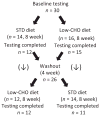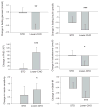Favourable metabolic effects of a eucaloric lower-carbohydrate diet in women with PCOS
- PMID: 23444983
- PMCID: PMC4111472
- DOI: 10.1111/cen.12175
Favourable metabolic effects of a eucaloric lower-carbohydrate diet in women with PCOS
Abstract
Objective: Diet-induced reduction in circulating insulin may be an attractive nonpharmacological treatment for women with polycystic ovary syndrome (PCOS) among whom elevated insulin may exacerbate symptoms by stimulating testosterone synthesis. This study was designed to determine whether a modest reduction in dietary carbohydrate (CHO) content affects β-cell responsiveness, serum testosterone concentration and insulin sensitivity in women with PCOS.
Design: In a crossover design, two diets ('Standard,' STD, 55:18:27% energy from carbohydrate/protein/fat; lower-carbohydrate, 41:19:40) were provided for 8 weeks in random order with a 4-week washout between.
Patients: Thirty women with PCOS.
Measurements: β-cell responsiveness assessed as the C-peptide response to glucose during a liquid meal test; insulin sensitivity from insulin and glucose values throughout the test; insulin resistance (HOMA-IR); and total testosterone by immunoassay.
Results: Paired t-test indicated that the lower-CHO diet induced significant decreases in basal β-cell response (PhiB), fasting insulin, fasting glucose, HOMA-IR, total testosterone and all cholesterol measures, and significant increases in insulin sensitivity and dynamic ('first-phase') β-cell response. The STD diet induced a decrease in HDL-C and an increase in the total cholesterol-to-HDL-C ratio. Across all data combined, the change in testosterone was positively associated with the changes in fasting insulin, PhiB and insulin AUC (P < 0·05).
Conclusions: In women with PCOS, modest reduction in dietary CHO in the context of a weight-maintaining diet has numerous beneficial effects on the metabolic profile that may lead to a decrease in circulating testosterone.
© 2013 John Wiley & Sons Ltd.
Conflict of interest statement
Nothing to declare.
Figures



References
-
- Fauser BCJM, Tarlatzis BC, Rebar RW, et al. Consensus on women’s health aspects of polycystic ovary syndrome (PCOS): the Amsterdam ESHRE/ASRM-Sponsored 3rd PCOS Consensus Workshop Group. Fertility and Sterility. 2012;97:28–38. e25. - PubMed
-
- Azziz R, Carmina E, Dewailly D, et al. Task Force on the Phenotype of the Polycystic Ovary Syndrome of The Androgen Excess and PS. The Androgen Excess and PCOS Society criteria for the polycystic ovary syndrome: the complete task force report. Fertility and Sterility. 2009;91:456–488. - PubMed
-
- Chang RJ, Nakamura RM, Judd HL, et al. Insulin resistance in nonobese patients with polycystic ovarian disease. Journal of Clinical Endocrinology and Metabolism. 1983;57:356–359. - PubMed
-
- Dunaif A. Insulin resistance and the polycystic ovary syndrome: mechanism and implications for pathogenesis. Endocrine Reviews. 1997;18:774–800. - PubMed
-
- Nestler JE, Jakubowicz DJ. Decreases in ovarian cytochrome P450c17-alpha activity and serum free testosterone after reduction of insulin secretion in polycystic ovary syndrome. New England Journal of Medicine. 1996;335:617–623. - PubMed
Publication types
MeSH terms
Substances
Grants and funding
LinkOut - more resources
Full Text Sources
Other Literature Sources
Medical
Research Materials

